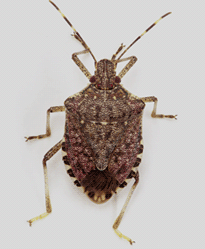
Updates
BMSB Management Survey for Commercial Producers
Participate in a nationwide survey to gather information from farmers and growers on the economic impact of the brown marmorated stink bug (BMSB) on agriculture.
A list of new articles published by our team of scientists and extension specialists through 2022.
October 11, 2021 Samurai Wasp
Our map of field recoveries of Trissolcus japonicus has been updated for 2021. Also known as the “samurai wasp,” Trissolcus japonicus is an egg parasitoid and a key natural enemy of brown marmorated stink bug.
September 16, 2021 Larry Gut, BMSB-SCRI co-PD, Passes Away
We regret to announce the passing of Larry Gut on September 6, 2021.
April 20, 2021 Stakeholder Advisory Panel Meeting, February 2021
Watch the recording and download presentations from the BMSB Stakeholder Advisory Panel Meeting, held February 17–18, 2021.
March 10, 2021 State-by-State
Our brown marmorated stink bug distribution map has been updated. BMSB has now been detected in Montana.
February 23, 2021 How Tiny Wasps Became Agricultural Defenders
Scientists are studying how different species of wasps can be used for insect biocontrol in the United States. Source: Smithsonian Magazine, Feb. 23, 2021.
December 29, 2020 Biological Control of Brown Marmorated Stink Bug Targeted by Samurai Wasp
The samurai wasp—a tiny wasp that lays its eggs into the eggs of stink bugs—has made its way to North America. After discovering it in Michigan in 2018, researchers began a program to rear and redistribute more of this important parasitoid in the state. Source: Fruit Growers News, Dec. 29, 2020.
April 22, 2020 Stakeholder Advisory Panel Meeting, February 2020
Download presentations from the BMSB Stakeholder Advisory Panel Meeting, held February 19, 2020.
Overview
The brown marmorated stink bug, Halyomorpha halys (Stål), is a voracious eater that damages fruit, vegetable, and nut crops in North America. With funding from USDA’s Specialty Crop Research Initiative, our team of more than 50 researchers is uncovering the pest’s secrets to find management solutions that will protect our food, our environment, and our farms.

Funding

Collaborators

